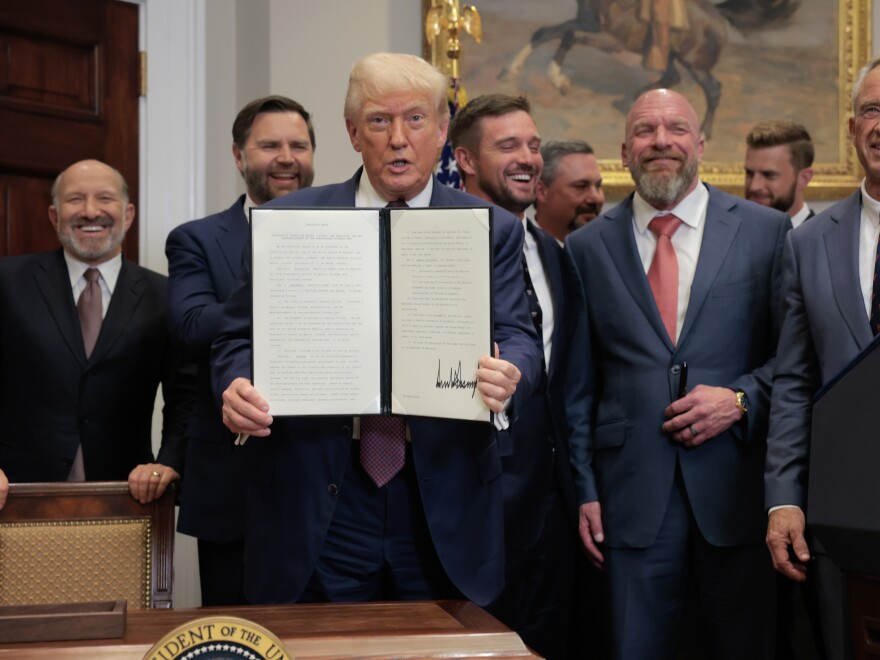Phrases like “shuttle run” and “sit-and-reach” probably bring back strong memories of the Presidential Fitness Test, which was formerly a mainstay of American physical education for generations of American kids. It is also scheduled to return to gymnasiums around the country as a result of a recent executive order.
The test, a series of standardized activities used by schools to gauge pupils’ physical health for more than 50 years until President Barack Obama phased it out in favor of a more comprehensive approach in 2013, was revived on Thursday by an order signed by President Trump. When the test will begin and which exercises will be included in it in the future are still unknown.
For kids between the ages of 10 and 17, it was customarily held once or twice a year and featured exercises including push-ups, the iconic one-mile run, and the back-and-forth PACER running test.
Additionally, it was competitive: Trump’s directive reinstates the Presidential Fitness Award, which was given to students who scored at or above the 85th percentile on all exercises.
Trump, surrounded by numerous elite athletes, stated during the signing ceremony, “The presidential fitness test was a big deal, with graduate scholars from all over our country competing against each other from the late 1950s until 2013.” “This was a wonderful tradition, and we’re bringing it back.”
Additionally, Trump is reviving the President’s Council on Sports, Fitness, and Nutrition and assigning it the responsibility of creating test standards. Robert F. Kennedy, Jr., Secretary of Health and Human Services, will oversee its implementation.
Kennedy’s “Make America Healthy Again” study, which was published in May, laments the drop in physical activity and fitness levels among American children, the rise in obesity rates, and what he refers to as the “childhood chronic disease crisis.”
Trump’s directive, which claims that Americans’ physical health is deteriorating and poses a “threat to the vitality and longevity of our country,” adds even more urgency, particularly as the United States approaches its 250th birthday and prepares to host the FIFA World Cup in 2026.
“Rates of obesity, chronic disease, inactivity, and poor nutrition are at crisis levels, particularly among our children,” the decree states. “These trends weaken our economy, military readiness, academic performance, and national morale.”
When the original test was adopted during the Cold War, leaders made a similar case on patriotism. However, since then, the patterns mentioned by the Trump administration have only gotten worse. Therefore, when it comes to their aspirations for a revised edition, experts and educators tell NPR they are being cautious.
Trump’s statement sparked a sharply mixed reaction in her professional network, according to Joanna Faerber, a physical education teacher who works with rural Louisiana schools on federal grants.
“We all agree that childhood obesity and lack of physical activity and physical education in school is limited,” she stated. “I think measuring it is the question.”
How did the test come about?
The Kraus-Weber test was developed in the 1940s by pioneering orthopedic surgeon Hans Krausnow, who is now regarded as the “father of sports medicine” in the United States, in collaboration with another physician, Sonja Weber. The test was created to assess fitness using exercises that target core strength and flexibility, such as sit-ups.
Kraus and Bonnie Prudden, another fitness enthusiast, began giving the test to thousands of pupils in the United States, Italy, Switzerland, and Austria in the 1950s. Researchers discovered that, in contrast to just 8.7% of European children, 58% of American children failed at least one component of the six-part exam.
Kraus stated, “We have no wish to change the standard of living by trying to do away with the automobile and television,” while showcasing their work at a White House event in 1955. “But we must make sure that we make up for this loss of physical activity.”
Their results, dubbed “The Report That Shocked the President” by Sports Illustrated at the time, prompted President Dwight Eisenhower to establish the President’s Council on Youth Fitness in 1956. (In this week’s order, Trump reconstituted that same council.) The council piloted its own national fitness exam the following year.
Building on Eisenhower’s momentum, President John F. Kennedy began a national public service effort to encourage Americans to hike the 50 miles that the U.S. Marines had previously been obliged to do. As president-elect in 1960, Kennedy wrote a seminal Sports Illustrated essay titled “The Soft American” that emphasized the importance of physical health. RFK Jr. discussed the article during the signing ceremony, and Trump mentioned it in his executive order.
“He was lamenting the fact that America had prided itself on a beef jerky toughness, and that we were falling behind Europeans, we were falling behind other nations,” Kennedy recalled about his uncle.
Under President Lyndon B. Johnson, the council’s third iteration codified the fitness exam in 1966 and included a reward system for exceptional performance.
Although its components did change over the years, the test eventually became a standard in American physical education curricula. It did away with the softball toss, for instance, which was thought to be more of a skill (for soldiers brandishing grenades) than a test of fitness.
“I think it was instilled to try to get people back in the ’60s ready to enter into the armed forces and get them fit for battle,” Laura Richardson, a clinical associate professor at the University of Michigan’s School of Kinesiology, told NPR. “And then as time evolved, they said, ‘We need to change this.'”
Why did the test go away?
The physical fitness exam has come under growing fire over the years for its detrimental effects on mental health. Many students saw it as a form of humiliation in front of their classmates, which fueled early body image worries.
Additionally, some questioned the test’s efficacy, arguing that its task-specific, one-size-fits-all design hindered personal progress toward a healthier way of living. Adult obesity rates increased from roughly 13% in 1960 to over 34% in 2008, according to data from the Centers for Disease Control and Prevention (CDC).
After the 2012–2013 school year, the Obama administration replaced the fitness test with the Presidential Youth Fitness Program and phased it out. By giving schools tools to evaluate and identify youth fitness, the voluntary program shifts the focus from athleticism to general health.
The FitnessGram Assessment, created by Texas Tech University’s Kenneth H. Cooper Institute, is used by many institutions to assess factors like muscular strength, flexibility, aerobic ability, and body composition.
Although there are currently little details available regarding Trump’s updated Presidential Fitness Test, the educators NPR spoke with expressed optimism that it will continue to place more emphasis on that type of health-related fitness than on particular abilities.
For the teachers who will administer the test and gather data from it, they would want to see it incorporate strong resources. Additionally, they believe that it will free up more time for schools to allow and encourage children to be active, not only to get ready for tests but also to develop lifelong habits.
“A fitness assessment is just to let you know where you are,” Faerber stated. “It’s not the end. It’s the start of something new.
The quantity of individual and population-level data needed to determine if the new test is effective would probably take years, according to Ricardson. Additionally, she points out that stress, sleep, nutrition, and fitness are all factors in childhood obesity.
“I think the biggest thing is that right now we have child fitness at the forefront,” she continues. “And that is what we need to be focusing on: How do we help kids get to where we want them to be, less about the test and more about how we get them there.”
Copyright 2025 NPR






